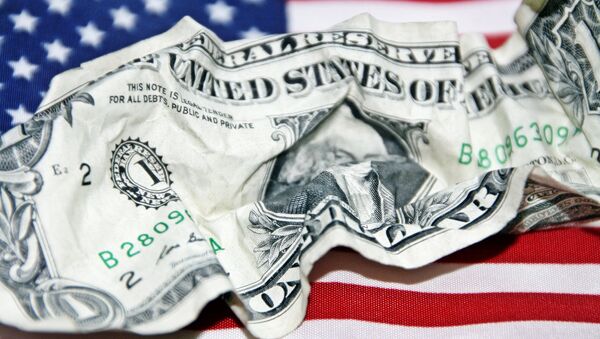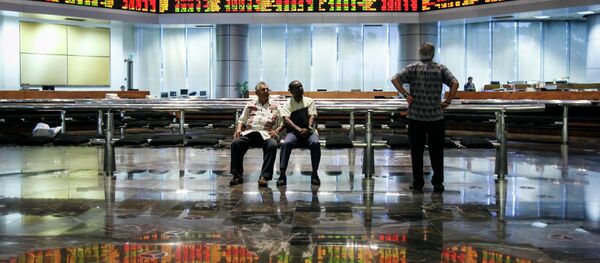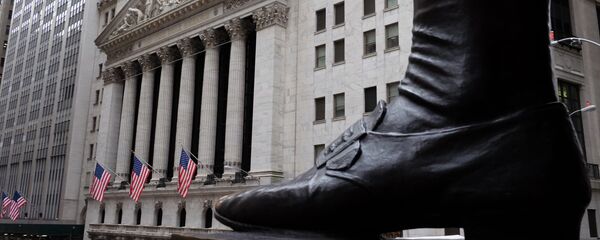Kristian Rouz – US economy has not fared well in 2015 thus far, staggering and almost nearing a halt in Q1 as the federal government has been gradually reducing its investment in the non-financial sector.
After the US Fed made clear the US borrowing costs would increase this year, presumably in September, one of the hotly debated issues of the moment has been whether such a change in economic policy will result in a dramatic downturn for the world’s first economy. Indeed, as the US economy is a debt-fueled one, with large part of its expansion attributed to the increased borrowing, more expensive loans might result in a decline in business activity and effective consumer demand. Simultaneously, the dollar, now at its 12-year highest, is bound to strengthen even more in case the base interest goes up, resulting in a significant loss on global competitiveness of the US enterprises, especially their overseas divisions – something we already witnessed on a smaller scale in Q1.
A decline in US economy is likely to trigger a massive cheering abroad. America’s economic woes, mainly its competitors in manufacturing exports from Germany and Japan, are already benefitting from a stronger dollar as their own exports are meeting more global demand as they are cheaper than similar American goods.
In international politics, America’s economic demise will significantly embolden the illiberal and anti-democratic regimes from Iran to mainland China to Venezuela, encouraging greater adventurism in their foreign policies, now often disrupted by Washington’s global presence seen as merely ‘annoying interference’.
Now, despite the slightly improved macro data arriving from America’s real economy, the recent greater picture is alarming at best. Q1 GDP expansion, now seen as stagnant, may well be revised into negative territory after a complex reassessment. Retail sales have been shrinking from January through to April, while manufacturing has been declining five months straight for the first time since 2009. All of these negative tendencies are largely attributed to harsh winter conditions, union strikes and a stronger dollar, in other words, the forerunners of the looming tightening in the US monetary policies.
America’s debt surpassed $16 trln and is still mounting despite the federal government taking several important steps to curb further borrowing.
America’s debt is currently enjoying a favourable investment rating, mainly to rife demand for Treasuries, but after the debt-to-GDP ratio surpasses 100%, a downgrade might be inevitable. According to some estimates, such a downgrade might happen as soon as America’s debt reaches $21-22 trln.
Unemployment is another concern. With official unemployment figures standing near all-time lows at 5.5%, the actual figure might be far above that as most recently added jobs are artificial government-sponsored non-productive welfare positions.
The real unemployment might be standing at 18% to 23%, which is not necessarily a bad thing for the economy as joblessness helps keep labour costs low. Most of these people (as much as 12% of the workforce) are actually underemployed and struggling to make ends meet deprived of the blessings of social benefits. However, rife unemployment is a negative factor for productivity and overall economic efficiency.
A large part of the US economy is trapped in a vicious circle of borrowing, investment, seeing stock markets go up, then a greater borrowing, and the process starts all over. The Fed’s policy change might disrupt the well-oiled scheme and prompt a great profits-taking from financial assets. Some of this money will end up in America’s real economy, but lion’s share will likely leave the country.
The issues America is facing economy-wise are simple though. The first being the ever-emerged stickiness of wages, hence the lack of growth sustainability as 71% of America’s GDP is driven by consumer spending. The second issue is underinvestment in the real economy. Meanwhile, the US government is pulling out of the economy, hoping for the private incentive to take up its role, while simultaneously weakening private incentive by increasing borrowing costs! Consequently, only large corporations can withstand these several headwinds combined, and that is where America is moving – towards increased monopolization in the real economy.




